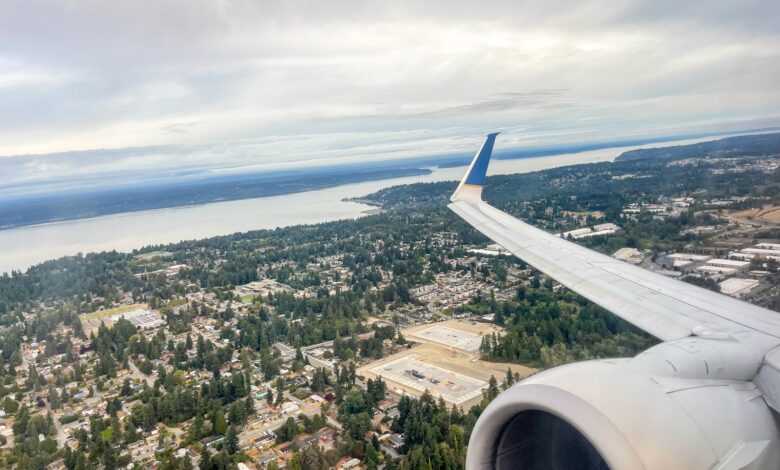Best frequent flyer programs in the US for 2024

For frequent and infrequent air travelers alike, a reliable and rewarding frequent flyer program can truly enhance your travel experiences. Fortunately, all major U.S. carriers offer loyalty programs that let you earn miles on flights but also for various non-flight activities. These programs provide various benefits, including priority boarding, airport lounge access and complimentary upgrades, depending on the airline you choose (and how frequently you fly).
With numerous airline programs, it can be challenging to determine which frequent flyer program is truly the best fit for your travel needs.
Today, we’ll delve into the high-level details of each program, highlighting the opportunities to earn miles, enjoy exclusive perks and make the most of your loyalty. We’ll look at network coverage, partner airlines, award availability and the overall value provided by each program. We’ll share strategies for maximizing your miles, achieving elite status and capitalizing on program benefits to ensure you get the most out of your travels.
Whether you’re a frequent business traveler or a leisurely vacationer, this guide will provide valuable insights to help you select the best frequent flyer program for your needs.
What is the best US frequent flyer program?
As expected, selecting the best U.S. frequent flyer program depends heavily on individual preferences and personal travel patterns. However, there are some details you can consider to help you make a more informed decision.
American Airlines AAdvantage: Best for earning status without flying
Despite moving to dynamic pricing on American Airlines flights (instead of offering fixed, predictable award rates), AAdvantage continues to offer some of the best redemption rates on partner carriers. AAdvantage members can redeem miles to travel on highly coveted airlines like Japan Airlines, Etihad Airways and Qatar Airways. You earn miles and AAdvantage elite status by earning Loyalty Points. Some popular ways to earn miles and Loyalty Points include flying American and its Oneworld partners, spending on an American Airlines cobranded credit card, shopping through the AAdvantage shopping portal and linking your World of Hyatt-American AAdvantage accounts.
United MileagePlus: Best for long-haul upgrades
United Airlines has historically offered the most extensive route network of the U.S. carriers. Although United recently increased global award rates without notice, MileagePlus miles and United Premier status remain valuable for the airline’s patrons. The airline is a founding member of Star Alliance, the largest airline alliance. Members can earn miles through flights, credit card spending and partners. The airline’s top elite members receive PlusPoints, which you can use to confirm upgrades to premium cabins like Polaris business class.
Delta SkyMiles: Best for making your status count
Delta Air Lines shocked travelers when it announced major changes to Medallion status by removing flight-based metrics and shifting entirely to spending requirements. This has led to elite status requirements increasing by 75% for Diamond Medallion members, 50% for Platinum and Gold Medallion members and 100% for Silver Medallion members year over year. To earn top-tier Diamond Medallion status on Delta starting in 2024, you must earn at least 35,000 Medallion Qualification Dollars. If you earn your status solely on Delta-issued tickets, that’s roughly double the spending requirement of earning American and United’s top-tier statuses. That likely means there will be far fewer upper-tier Medallion elite members in the future, so you can hopefully expect more upgrades and better status recognition.
But there’s bad news for non-elite Delta SkyMiles members too. Delta SkyMiles ranked among the least valuable airline miles on our recent data-backed valuations. Members can earn miles through flights, credit card spending and partners — but the program has minimal opportunities to maximize your rewards.

Daily Newsletter
Reward your inbox with the TPG Daily newsletter
Join over 700,000 readers for breaking news, in-depth guides and exclusive deals from TPG’s experts
Alaska Airlines Mileage Plan: Best for Alaska travelers in the Pacific Northwest
Mileage Plan is best for frequent travelers who fly with Alaska Airlines or its partner airlines. With an extensive partner network and a generous (but increasingly devalued) partner award chart, it offers great value for the airline’s loyal flyers. The airline also offers traveler-friendly policies such as free stopovers on award tickets. Its Mileage Plan elite status offers perks like complimentary upgrades on Alaska and some American Airlines-operated flights, lounge access on select international itineraries and priority boarding. You can earn Alaska miles on transactions like flying, spending on the Alaska Airlines Visa® card or initiating online purchases on the Mileage Plan shopping portal.
JetBlue TrueBlue and Southwest Rapid Rewards: Best for simplicity
JetBlue TrueBlue and Southwest Rapid Rewards are the best simple options due to their straightforward and user-friendly programs. These loyalty programs stand out for their uncomplicated earning and redemption processes.
TrueBlue members earn points based on the cost of their flights, and there are no blackout dates for award travel. It overhauled its elite status program earlier this year, adding a variety of new tiers and benefits. It also launched long-haul international service, with flights from both Boston Logan International Airport (BOS) and New York’s John F. Kennedy International Airport (JFK) to Amsterdam Airport Schiphol (AMS), London’s Heathrow Airport (LHR) and London Gatwick Airport (LGW). It also flies nonstop from JFK to Paris-Charles de Gaulle Airport (CDG).
Southwest Rapid Rewards also offers a simple points-based system, with no blackout dates and the ability to earn the buy one, get one free Companion Pass. It serves a variety of destinations in the Caribbean and Central America along with frequent flights from the West Coast to Hawaii.
These programs prioritize transparency, lack complex rules and provide clear benefits, making them ideal choices for travelers seeking straightforward loyalty programs.
Related: What exactly are airline miles, anyway?
How do you choose a frequent flyer program?
Here are some factors to consider when selecting a frequent flyer program.
Hub cities and where you fly
Airline hubs play a crucial role in connecting flights across the U.S. If you live in a hub city, choosing your hometown carrier for more nonstop options may be the way to go. When selecting a frequent flyer program, consider the proximity of airports near you, as this can impact your decision.
Here’s a look at the major airlines and their hubs:
- Alaska Airlines: Ted Stevens Anchorage International Airport (ANC), Los Angeles International Airport (LAX), Portland International Airport (PDX), San Francisco International Airport (SFO) and Seattle-Tacoma International Airport (SEA)
- American Airlines: Charlotte Douglas International Airport (CLT), Chicago’s O’Hare International Airport (ORD), Dallas Fort Worth International Airport (DFW), LAX, Miami International Airport (MIA), JFK, New York’s LaGuardia Airport (LGA), Philadelphia International Airport (PHL), Phoenix Sky Harbor International Airport (PHX) and Ronald Reagan Washington National Airport (DCA)
- Delta Air Lines: Hartsfield-Jackson Atlanta International Airport (ATL), BOS, Detroit Metropolitan Wayne County Airport (DTW), Minneapolis-St. Paul International Airport (MSP), JFK, LGA, Salt Lake City International Airport (SLC) and SEA
- JetBlue: BOS, Fort Lauderdale-Hollywood International Airport (FLL), LAX, JFK, LGA, Orlando International Airport (MCO) and San Juan, Puerto Rico’s Luis Muñoz Marín International Airport (SJU)
- Southwest Airlines: ATL, Baltimore/Washington International Thurgood Marshall Airport (BWI), Chicago’s Midway International Airport (MDW), Dallas Love Field (DAL), Denver International Airport (DEN), FLL, Houston’s William P. Hobby Airport (HOU), Harry Reid International Airport (LAS), LAX, Nashville International Airport (BNA), MCO and PHX
- United Airlines: ORD, DEN, Guam’s Antonio B. Won Pat International Airport (GUM), Houston’s George Bush Intercontinental Airport (IAH), LAX, Newark Liberty International Airport (EWR), SFO and Washington, D.C.’s Dulles International Airport (IAD)
Beyond that, consider whether you have any frequent travel spots. If you’re traveling the same route for work at least once a month, or if you’re flying to see your parents or grandkids in the same city multiple times per year, you should pick an airline that serves those destinations.
Is it easy to earn your airline miles?
Earning airline miles can vary in ease depending on various factors. Carefully consider your priorities. If it’s important for you to hold top-tier status and have a credit card with no annual fee, you can spend $200,000 annually on everyday purchases on the American Airlines AAdvantage® MileUp® card and subsequently earn 200,000 Loyalty Points without any flight activity. Lower annual spend amounts unlock lower tiers in the AAdvantage elite program (i.e., $40,000 for AAdvantage Gold, $75,000 for AAdvantage Platinum and $125,000 for AAdvantage Platinum Pro members).
Similarly, if you spend $350,000 annually on the Delta SkyMiles® Reserve American Express Card, you’ll earn the 35,000 MQDs required for top-tier Diamond Medallion status without any flight activity. Like AAdvantage, lower spend amounts unlock lower tiers in the Medallion elite program (i.e., $60,000 for Silver Medallion, $120,000 for Gold Medallion and $180,000 for Platinum Medallion).
But if you go with these elite-status-centric options, you’ll sacrifice the value of your redeemable rewards. For example, all purchases (outside of Delta) on the Delta SkyMiles® Reserve American Express Card earn just 1 mile per dollar, a marginal 1.2% return based on TPG’s latest valuations. Meanwhile, all purchases on the Capital One Venture X Rewards Credit Card earn at least 2 Capital One miles per dollar, which is a 3.7% return based on our valuations (or at least a 2% return if you use your miles to cover travel purchases).
And by carrying multiple credit cards and spending on whichever earns the most, the difference can be even more significant.
For example, the American Express® Gold Card earns 4 Amex points per dollar spent at restaurants worldwide, plus 4 points per dollar spent at U.S. supermarkets (on up to $25,000 in spending each calendar year), both of which represent an impressive 8% return at our valuations.
You might also consider airlines with transfer partners so you can transfer credit card points to airline miles. You can transfer Bilt Rewards points from the Bilt Mastercard® (see rates and fees) to programs like American AAdvantage and United MileagePlus. For Delta SkyMiles, you can transfer American Express Membership Rewards from cards like the American Express® Gold Card and The Platinum Card® from American Express at a 1:1 ratio. Note that a transfer excise tax applies.
Is it easy to use your airline miles?
While earning airline miles can be relatively straightforward, redeeming them can sometimes be challenging. It’s important to carefully review an airline’s policies, restrictions and fees when redeeming miles for flights. While many airlines have eliminated blackout dates, they have implemented dynamic pricing, which means the number of miles required to book flights during peak travel periods or holidays can be significantly higher.
For example, you can book flights on United from SFO to the Big Island’s Ellison Onizuka Kona International Airport at Keahole (KOA) from just 9,800 United miles. However, during peak dates, these economy-class award rates can increase to 90,000 miles one-way.
If you don’t have the time, flexibility or interest in dealing with airline saver award space, you might be better off applying your credit card points toward the cash price of an airline ticket. Cardholders with a Capital One Venture Rewards Credit Card or Venture X can reimburse themselves for eligible travel purchases made within the last 90 days at a fixed 1 cent per Capital One mile rate (i.e., a $100 reimbursement costs 10,000 miles.). Book your flight with the airline, pay with your Capital One card and follow these steps to reimburse yourself.
Alternatively, Chase Sapphire Reserve cardholders can redeem their points at 1.5 cents apiece in the Chase travel portal. A $450 flight would cost 30,000 Chase Ultimate Rewards points.
Although this isn’t the best use of Capital One miles or Chase points, you’ll generally still earn frequent flyer miles and work toward elite status since airlines recognize these purchases as paid tickets.
Consider how easy it is to redeem airline miles with your travel patterns, especially if you travel during busy travel times.
Related: 5 reasons I pursued elite status with a foreign airline
Are airline frequent flyer programs worth it?
Even if elite status is out of reach, you should earn miles on all your eligible tickets. These programs offer benefits like earning miles through flights, credit card spending and partner activities. Depending on the program, you can redeem your hard-earned miles for award flights, upgrades and other perks. Additionally, many popular currencies — including Delta SkyMiles, JetBlue TrueBlue points, Southwest Rapid Rewards points and United MileagePlus miles — never expire. Even if it takes you years to earn enough miles to book anything meaningful with them, there’s no risk to joining.
Frequent flyer programs often provide perks such as priority boarding, complimentary upgrades and enhanced customer service for elite members as well. For frequent travelers or those who can strategically maximize their mileage earnings and redemptions, these programs can provide significant value and enhance the overall travel experience. However, it’s important to consider your travel habits and preferences to determine if the benefits outweigh the cost of elite status.
Related: The best airlines in the US for 2023
Bottom line
If you’re ready to select the best airline program, consider your home airport, targeted destinations and which airline(s) best meet your needs. Additionally, consider the ease of earning and redeeming miles when evaluating an airline rewards program.
Regardless of the airline loyalty program you select, it might make sense to hold your carrier’s cobranded credit card to supercharge your mileage balance with a welcome bonus. Airline cobranded credit cards often include benefits like a free checked bag and no foreign transaction fees, which can be cost-saving tools when you travel.
American AAdvantage offers excellent partner airlines and award rates, while United MileagePlus provides valuable long-haul upgrades. Delta SkyMiles focuses on making elite status count (especially in 2024), and the Alaska Airlines Mileage Plan is ideal for travelers in the Pacific Northwest. JetBlue TrueBlue and Southwest Rapid Rewards offer user-friendly programs with clear benefits for those seeking simplicity.
Selecting the right program will enhance your travel experiences and reward your loyalty — but why stop there? Joining all of these programs is completely free, so you have nothing to lose by signing up.
See Bilt Mastercard rates and fees here.
See Bilt Mastercard rewards and benefits here.




